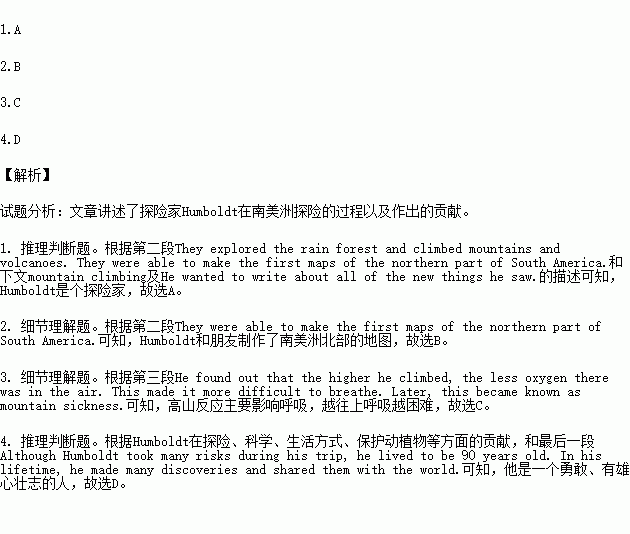题目内容
Alexander von Humboldt was born in 1769 in Berlin, Germany. As a young boy, he wanted to learn about the world. Humboldt followed his dream. In 1799, he traveled with a friend to Central and South America.
On their trip, Humboldt and his friend saw and did many things. They sailed down the Amazon River. They watched dolphins play in the ocean. They explored the rain forest and climbed mountains and volcanoes. They were able to make the first maps of the northern part of South America.
Humboldt set a world record for mountain climbing. He also made a discovery. During his climb, Humboldt became very sick. He found out that the higher he climbed, the less oxygen there was in the air. This made it more difficult to breathe. Later, this became known as mountain sickness.
Science was another part of Humboldt’s interests. He wanted to write about all of the new things he saw. He described the new plants, animals, and rocks which had never been seen by scientists before.
Humboldt also studied the way of life of the local people. He learned how the native people along the Amazon River used plants in their daily lives. For example, they used a strong poison from a vine(蔓生植物) to make poisoned arrows. The natives used these arrows for hunting their food.
The Amazon Indians also used a native plant to treat malaria (疟疾), a serious illness. The plant grew wild, but after it was dug up, it was never replanted. Humboldt warned the natives that the plant was in danger of dying out. He looked for ways to preserve the plant and to make it grow strong.
Although Humboldt took many risks during his trip, he lived to be 90 years old. In his lifetime, he made many discoveries and shared them with the world. As a tribute (颂扬) to Humboldt, there are rivers and mountains named after him.
1.We can infer that Humboldt was probably a (n) ________.
A. explorerB. inventorC. doctorD. writer
2.Humboldt and his friend made maps of ________.
A. the central part of South America
B. the northern part of South America
C. the north part of Central America
D. the southern part of Central America
3.What do we know about mountain sickness?
A. It can be treated with a plant.
B. It is a serious illness like malaria.
C. It mainly influences one’s breathing.
D. It was discovered by Humboldt’s friend.
4.We can tell from the text that Humboldt was ________.
A. easy-goingB. imaginativeC. optimisticD. ambitious
假定你是李华,是Writing.Com的会员,近日收到如下邮件,邀请你尝试成为付费会员并上传作品。请结合邮件给予回复,解释你之前未上传作品的原因,并提出建议。
Hello, Li Hua! We noticed you’ve never tried a Writing.Com paid membership or upload any writing, so we’re offering you a discount to give it a go… A BIG discount: Take 50% off any paid membership of $19.95 or more. Visit our shop: http://Writing.Com/main/shop/cat/Memberships |
注意:
1. 词数100左右;
2. 可以适当增加细节,以使行文连贯;
3.开头和结尾已给出,不计入总词数。
Dear Sir or Madam,
I have received your email which offers me a big discount. ___________________
_______________________________________________________________________________
_______________________________________________________________________________
_______________________________________________________________________________
_______________________________________________________________________________
_______________________________________________________________________________
_______________________________________________________________________________
_______________________________________________________________________________
_______________________________________________________________________________
_______________________________________________________________________________
_______________________________________________________________________________
Li Hua

